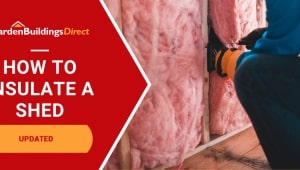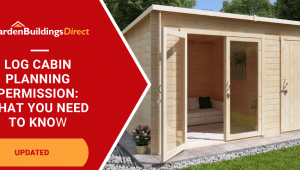Jump to:
Fitting a playhouse in a garden is one job—getting furniture inside is another. If you’ve managed the first, congratulations! And if you’re about to tackle the second, we’ve got some tips and ideas that will help you big time!
Some can be DIYed while others can be bought online or in-store, but we’ll keep the cost as low as possible for the options. Ready?
Beanbags
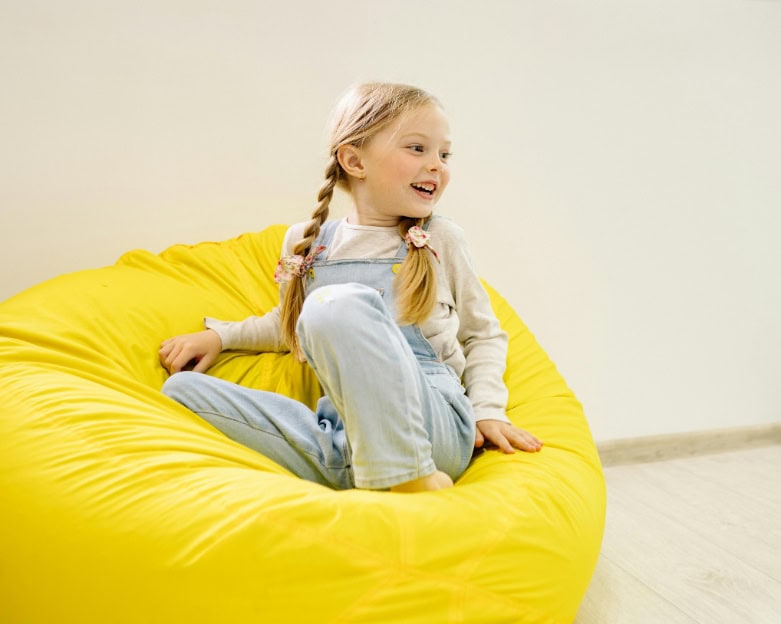
It’s hard to beat beanbags for a play house: they’re light, compact, and easy to move around. Not to mention, they’re comfy to sit on, with ergonomic features that can help with posture. Overall, they make a fun seating option that still leaves enough room to squirm around.
Sizes can vary, but compact beanbags are best for small playhouses like a Wendy house—two could fit in. Feel free to opt for large or extra-large if the space allows. Either way, this type of seating won’t take up much room, leaving space for more furniture.
Best for: Kids of all ages, including toddlers.
Kids Chairs
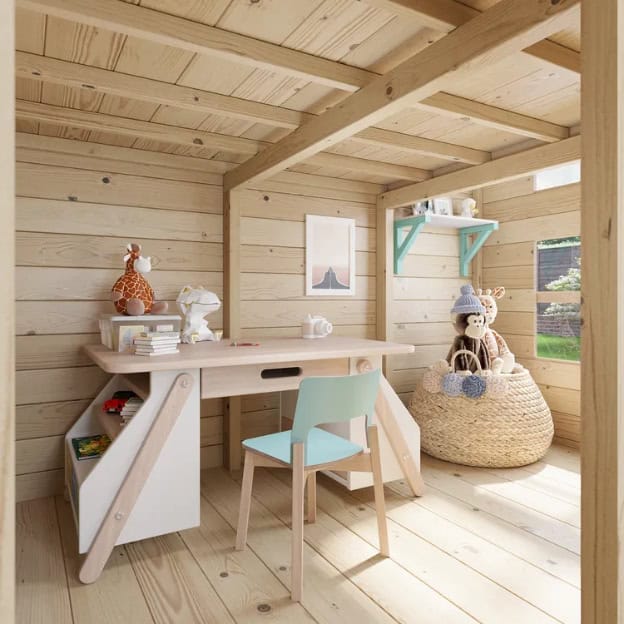
Plastic chairs are more solid than beanbags, while still being lightweight and safe. Most have multiple colour options to add playful elements to the set-up. Their sizes are much smaller than usual seating, so they’ll definitely fit inside a playhouse. A matching table would also be nice for a little dining area for hosting a tea party with friends or soft toys.
Tips: Look for plastic kids’ chairs that meet BS EN71-1. This standard ensures the furniture is safe for children’s use. You also might want to consider placing seat cushions for extra comfort.
Best for: Kids who can sit up unassisted.
Mattress
A mattress makes a practical addition, especially to a two storey playhouse with a bunk. Foam and memory foam are great options, including foldable types if the loft is tight. As simple as this can give your little ones a nap spot—when you think it through, it can double as a cushioned surface.
Tips: If the bunk area has high headroom, a bedframe could work, but consider the weight and if it can support it. For DIY, use lightweight materials free from sharp edges and toxic substances.
Best for: Children who are old enough to climb up and use the bunk on their own.
Shelving Units
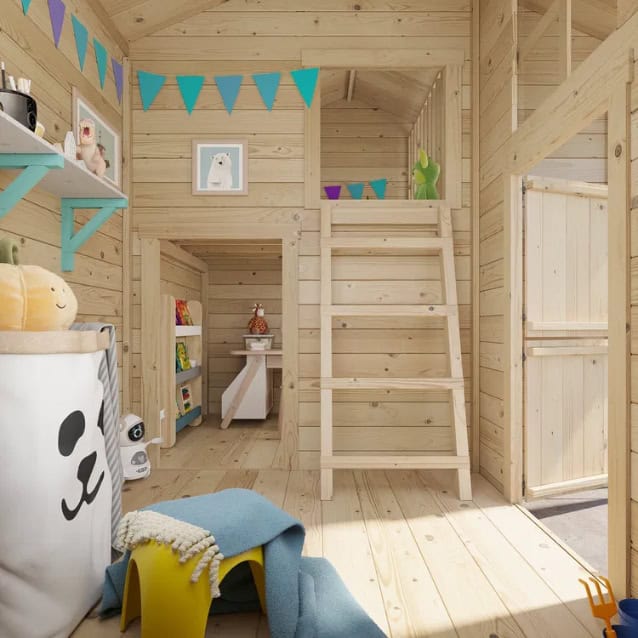
Shelves are a must with all the toys and knickknacks, keeping the playhouse organised. You can choose from small, single-shelf tacks to large, multi-tiered designs.
Wall shelves are great for saving floor space, while freestanding can be tucked in the corner. If you want a cabinet, go for a larger one (as long as it’s within the unit’s size range) so you can store everything in one place.
If none of the available sizes on the market suit the playhouse, DIY is the way to go! One idea is using untreated pallets, which are cheap and easy to work with. With a few pieces, you can create wall-mounted shelves, a shelf display, or a cupboard. The best part is, you can adjust the dimensions as needed.
Tips: Give any rough or sharp edges a good sand down to avoid any cuts or scrapes on curious little hands. If you can, round off the corners too. If you’re painting or staining the pallet, make sure to use a non-toxic, child-safe paint or finish. And don’t forget to check for small bits like nails or screws that could come loose and become a choking hazard.
Best for: All types of kids’ playhouses, no matter the size.
Play-Specific Furniture
These are bigger toy sets made to suit kids’ activities for imaginative play. They often have child-friendly sizes and features, so they’re easy to use and safe. The purpose is to make the playhouse a more interactive environment. Once set, it creates a space where kids can role-play and mimic real-life scenarios.
Some good examples include:
Pretend kitchen
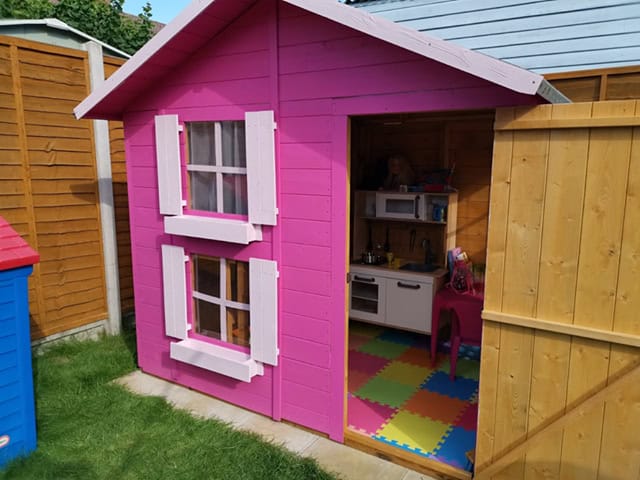
Pretend kitchens are the miniature versions of mum and dad’s kitchen. Despite the size matching a little one’s, they feel like a full-fledged cook or baker of their own space.
These kitchen sets can vary depending on the product, but all feature the same kitchen items. They usually have a little stove, oven, sink, and sometimes a fridge or microwave. In terms of material, they’re made from wood or plastic, with buttons that make noises or doors that open and close. You’ll also find toy utensils, pots, and plates to help kids act out cooking and serving meals.
The mini plastic dining set we mentioned earlier would look lovely with this setup, don’t you think?
Best for: Kids aged three (3) and up who enjoy “cooking,” serving food, or hosting tea parties.
Toy music instruments
A playhouse can be turned into a band room or mini concert area. Enter toy musical instruments, where your little artists can have pretend performances (admissions are free for parents!).
These sets can include things like tambourines, mini keyboards, and even small drums. Some might just include one or two, so kids can set them up however they like.
If the layout is within a tower playhouse, the unit is likely to have an extended platform. This would make a brilliant stage for performances, with the viewers sitting on the lawn. Afterwards, the instruments can be returned inside, ready for the next use.
That’s just an idea—feel free to let the kids have a go at designing the playhouse their way!
Best for: Young artists aged three (3) and older who love making music and being creative.
Pretend grocery store
It’s like having their own supermarket, role-playing as shopkeepers or customers. So imagine the playhouse like a store but on a much smaller scale. The furniture set can include toy food items, baskets, and counters to display the goods. But what your kids will really enjoy is a toy cash register that makes the experience realistic.
Best, they can learn about shopping, counting, and social skills while having fun.
DIY options
Simpler sets are pretty affordable, especially if they’re made from plastic. But if you’re after those with extra features, like lights or sounds, they can be a bit pricier. Don’t worry, as there are options to fit all kinds of budgets, from basic sets to fancier ones, including DIYs.
With the right tools, materials, and a bit of woodworking know-how, you can build a kitchen or grocery store. For instance, you could make a simple wooden counter, shelves for toy food, or a cash register.
Round-up
Beanbags are a fun seating option for the playhouse. Plastic kids’ chairs are great too, especially if you’re thinking of matching them with a dining table. A mattress might seem a bit unusual, but it can be really useful for bunks. Shelving units are always handy for storage and keeping the playhouse tidy.
For pretend furniture, a kitchen, toy music, and a grocery store are popular choices. Even outside the playhouse, you’ll often find them in kids’ bedrooms or playrooms.
There are plenty of other options out there, but we hope this list gives you a helpful kick-off!
Looking for a playhouse? Find out which option is best for your little ones here: Plastic vs Wood Playhouses – Which is Better for My Kids?

